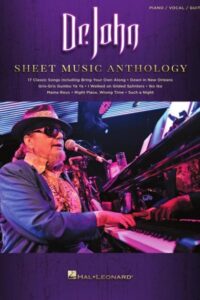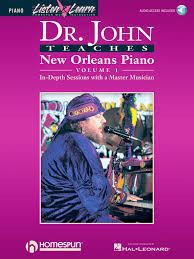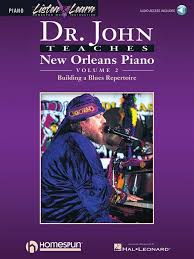Come join us now, and enjoy playing your beloved music and browse through great scores of every level and styles!
Can’t find the songbook you’re looking for? Please, email us at: sheetmusiclibrarypdf@gmail.com We’d like to help you!
Table of Contents
Dr John Piano transcriptions Vol. 1 & 2

Search your favorite sheet music in the Sheet Music Catalog

Please, subscribe to our Library.
If you are already a subscriber, please, check our NEW SCORES’ page every month for new sheet music. THANK YOU!
The Night Tripper: An Exhaustive Exploration of Dr. John
In the vast and colorful tapestry of American music, few figures are as singular, as steeped in mystery and tradition, and as fundamentally funky as Dr. John, the Night Tripper. Born Malcolm John “Mac” Rebennack Jr., he was not merely a musician; he was a living embodiment of the rich cultural heritage of New Orleans. He was a pianist, guitarist, singer, and songwriter whose career spanned over six decades, weaving together strands of rhythm and blues, boogie-woogie, rock and roll, jazz, funk, and the deepest, darkest gris-gris of Louisiana voodoo. To understand Dr. John is to take a journey into the soul of one of America’s most musically fertile cities.

Browse in the Library:
Or browse in the categories menus & download the Library Catalog PDF:
Biography: From Session Man to the Voodoo King
Malcolm John Rebennack Jr. was born in New Orleans on November 21, 1941. His upbringing was immersed in music. His father ran an appliance store that also sold records, exposing the young Mac to a vast array of sounds. The city itself was his conservatory. He heard the jazz pouring out of Preservation Hall, the R&B on the radio, the Mardi Gras Indian chants, and the spirituals from the churches. He began his musical life as a guitarist, learning from legends like Walter “Papoose” Nelson and Paul Gayten. By his teens, he was a prodigious talent, playing on seminal recordings at Cosimo Matassa’s famed J&M Studio with artists like Professor Longhair, Frankie Ford (“Sea Cruise”), and Joe Tex.
The late 1950s and early 1960s were a period of apprenticeship and, unfortunately, dissolution. Rebennack became deeply involved in the seedy underworld of the New Orleans music scene, a world of drugs, gangsters, and after-hours clubs. A pivotal moment came in 1961 when he was shot in the finger during a brawl while defending his bandmate, singer Ronnie Barron. The injury effectively ended his career as a frontline guitarist, forcing him to refocus his energies on the piano and organ. This seemingly catastrophic event was a blessing in disguise, steering him toward the instrument that would become his primary voice.
Following a prison stint for drug possession and a move to Los Angeles in the mid-60s, Rebennack conceived a persona that would change his life and the landscape of popular music. Drawing on the legend of a 19th-century New Orleans witch doctor and free man of color named Dr. John Montaine, and inspired by his friend and collaborator, the charismatic singer/priest “Prince” La La, he created “Dr. John, The Night Tripper.” This was no mere stage name; it was a full-blown theatrical character—a hoodoo sorcerer, a purveyor of musical and spiritual potions.
His 1968 debut under this new moniker, Gris-Gris, was a psychedelic voodoo masterpiece that baffled critics and slowly built a cult following. It was unlike anything in the mainstream, a swampy, hypnotic blend of New Orleans rhythms, spooky incantations, and Creole patois. The character allowed him to channel the entire mystical history of his hometown into a potent new art form. Over time, the most overt psychedelic and voodoo trappings receded, but the essence of the Night Tripper—the deep, soulful, and slightly sinister connection to the old ways—remained the core of his artistry until his death on June 6, 2019.
Music Style and Harmony: The New Orleans Piano Tradition
Dr. John’s musical style is a direct continuation of the New Orleans piano “professors”: Professor Longhair, Tuts Washington, and Champion Jack Dupree.
- Rhythmic Foundation: The foundation of his style is the “New Orleans Clave,” a syncopated, two-bar rhythmic pattern often played by the piano. Professor Longhair’s signature tune, “Tipitina,” is the archetype, with its rolling bass figures and trilling right hand. Dr. John internalized this rhythm so completely that it became the heartbeat of everything he played, whether a slow blues or an uptempo funk number.
- The “Big Four”: A crucial element in his comping (accompanying) style is the emphasis on the “and of two” and the “and of four” on the snare drum, a syncopated pattern that creates immense forward momentum. His left hand would often mimic this, playing heavy, percussive chords on these off-beats.
- Harmonic Language: Harmonically, his music is rooted in the blues, but it is far from simple. He liberally used:
- Dominant 7th Chords: The bread and butter of blues and R&B.
- Extended Harmony: 9ths, 11ths, and 13ths were common, adding color and sophistication.
- Chromaticism: He was a master of sliding chromatic passing chords to connect harmonic changes, a technique deeply embedded in the New Orleans tradition.
- Modal Mixture: He would freely borrow chords from the parallel minor key, creating a soulful, melancholic tension.
A perfect example of his harmonic sophistication is his classic, “Such a Night.” The chord progression is not a standard I-IV-V blues. It moves through a series of lush, descending chords (e.g., C – C7 – F – F#dim7 – C/G – Am7 – Dm7 – G7), creating a sense of narrative and longing that perfectly complements the lyrics. His playing was a conversation between a rock-solid, rhythmic left hand and a florid, improvisational right hand that could deliver barrelhouse boogie, delicate filigrees, or dissonant, “wrong” notes that felt perfectly right.
Improvisational Licks and Vocabulary
Dr. John’s improvisations were less about lightning-fast runs and more about storytelling, feel, and rhythmic interplay. His licks were deeply idiomatic, drawn from the well of New Orleans piano.
- The Trill and Turn: A direct inheritance from Professor Longhair. He would rapidly alternate between two adjacent notes (a trill), often resolving with a quick turn or a slide. This was used to build excitement, especially over a static chord.
- The Octave Roll: A powerful, rolling figure where he would play a note and its octave in a rapid, repeated pattern, creating a thunderous, percussive effect that could drive a song to its climax.
- Blues-Based Bending: On the piano, you can’t bend notes like a guitarist, but you can create the illusion. He would use microtonal slides with his fingers or play rapid alternations between a blue note (like a flatted third or fifth) and the standard note to create a vocal, crying effect.
- Quoting and Referencing: His solos were often filled with subtle (and not-so-subtle) quotes from other New Orleans standards, jazz tunes, or even children’s songs. This created a deep intertextuality, a musical wink to those in the know. A solo might suddenly veer into a phrase from Fats Domino’s “Blueberry Hill” or a traditional Mardi Gras Indian chant.
- Rhythmic Displacement: He was a master of starting a phrase on an unexpected beat, creating a sense of syncopation that was both disorienting and deeply funky. He would play “behind the beat,” giving his music a lazy, smoky, late-night feel that was utterly compelling.
Cooperation with Other Artists
Dr. John was a collaborator par excellence. His career is a who’s who of 20th-century music.
- The Wrecking Crew & Early Sessions: In his Los Angeles years, he was a key part of the “Wrecking Crew” session scene, playing on records by Sonny & Cher, Frank Zappa, and Canned Heat.
- The Band: He performed with The Band at their legendary farewell concert, captured in Martin Scorsese’s The Last Waltz, delivering a show-stopping, funky version of “Such a Night.”
- Van Morrison: He had a long and fruitful partnership with Van Morrison, co-writing and playing on several albums, including the acclaimed A Period of Transition.
- The Rolling Stones: He played on the Stones’ 1972 album Exile on Main St., contributing piano and clavinet to tracks like “Let It Loose,” adding a distinct New Orleans grease to their rock and roll swagger.
- Modern Collaborations: In his later years, he worked with a diverse range of artists, from Dan Auerbach of The Black Keys (who produced his 2012 Grammy-winning album Locked Down) to Willie Nelson, Norah Jones, and the Kronos Quartet. His final album, Things Happen That Way (2022), featured posthumous collaborations with Lukas Nelson and Willie Nelson.
Influences and Legacy
Influences:
Dr. John’s influences are the foundational pillars of New Orleans and American music: Professor Longhair (his “bach”), Champion Jack Dupree, Ray Charles, Fats Domino, Little Richard, Louis Armstrong, and the entire pantheon of blues and jazz greats. He was also deeply influenced by the spiritual and ceremonial music of the Mardi Gras Indians and the voodoo traditions of the city.
Legacy:
Dr. John’s legacy is immense and multifaceted.
- Cultural Ambassador: He was perhaps the most potent global ambassador for the culture and music of New Orleans in the late 20th and early 21st centuries.
- Musical Synthesis: He proved that deep, traditional roots music could be fused with psychedelia, funk, and modern production to create something timeless and unique.
- The Theatrical Persona: He paved the way for other artists to use elaborate personas and theatricality in rock and pop music, from David Bowie to George Clinton.
- Post-Katrina Voice: After Hurricane Katrina, he became a powerful voice for his devastated city, releasing the politically charged album City That Care Forgot (2008), which won a Grammy for Best Contemporary Blues Album. His advocacy kept the plight of New Orleans in the public consciousness.
Major Works and Most Known Compositions
While he was a master interpreter, his own compositions form a remarkable body of work.
- “Right Place, Wrong Time” (1973): His biggest commercial hit. A funky, frustrated lament with an indelible groove and a killer guitar riff from Mac “Dr. John” Rebennack himself. It perfectly encapsulates his ability to make profound observations feel like a party.
- “Such a Night” (1973): A slow-burning, seductive masterpiece. Its sophisticated chord changes and sultry delivery make it one of his defining performances.
- “Iko Iko” (1972): His version of the traditional Mardi Gras Indian chant, featured on his album Dr. John’s Gumbo, introduced this New Orleans staple to a worldwide audience.
- “Walk on Gilded Splinters” (1968): The epic, hypnotic opening track from Gris-Gris. With its insistent, repeating bass line, eerie backing vocals, and incantatory lyrics, it is the definitive statement of the Night Tripper persona and one of the most atmospheric songs ever recorded.
- “Tipitina” (1972): His tribute to Professor Longhair on the album Dr. John’s Gumbo. It is a faithful yet personal rendition of the song that defines the New Orleans piano style.
Filmography
Dr. John’s distinctive presence made him a natural for film and television.
- The Last Waltz (1978): Martin Scorsese’s concert film, featuring his unforgettable performance.
- The Blues Brothers (1980): He appeared as the bandleader for Bob’s Country Bunker, playing “Rawhide.”
- Sgt. Pepper’s Lonely Hearts Club Band (1978): He played a cameo as a future villain.
- Streets of Fire (1984): He was the bandleader for the fictional Blacktops.
- He also made numerous appearances on shows like Sesame Street and provided voice work for animated films.
Discography (Selective)
Dr. John released over 30 studio albums. Here are the essential entries:
- Gris-Gris (1968): The groundbreaking debut. A psychedelic voodoo ritual.
- Babylon (1969) & Remedies (1970): Continue the Night Tripper concept with increasing ambition.
- The Sun, Moon & Herbs (1971): Features an all-star cast including Eric Clapton and Mick Jagger.
- Dr. John’s Gumbo (1972): A back-to-roots triumph. A loving tribute to the New Orleans R&B classics of his youth.
- In the Right Place (1973): Produced by Allen Toussaint with The Meters as his backing band. His commercial peak.
- Desitively Bonnaroo (1974): The follow-up to In the Right Place, another funky collaboration with Toussaint and The Meters.
- Goin’ Back to New Orleans (1992): A sprawling, heartfelt tribute to his hometown’s musical history.
- Anutha Zone (1998): A late-career highlight featuring collaborations with Paul Weller and members of Spiritualized.
- Locked Down (2012): Produced by Dan Auerbach, a raw, gritty, and Grammy-winning comeback.
- Things Happen That Way (2022): His final album, a poignant collection of country and gospel tunes released posthumously.
Dr. John: The Spirit of New Orleans
Dr. John was more than a musician; he was a shaman, a historian, a raconteur, and the keeper of a sacred flame. His music was a bubbling cauldron containing all the joy, sorrow, mystery, and funk of New Orleans. From the shadowy, incense-filled rooms of his “Gris-Gris” period to the sun-drenched, good-time funk of his hits and the wise, weathered grace of his final recordings, he never lost the essence of Mac Rebennack: a kid from the Third Ward who absorbed every sound his city had to offer and gave it back to the world, transformed by his unique and magical spirit. He was, and remains, the Night Tripper, the Gris-Gris Man, the unmistakable voice and piano of a city that, like him, refuses to be categorized and forever dances to its own irresistible rhythm.
Dr. John – Such a Night
From “The Last Waltz”.
Listen to Dr John music on Spotify
Browse in the Library:
Or browse in the categories menus & download the Library Catalog PDF:
